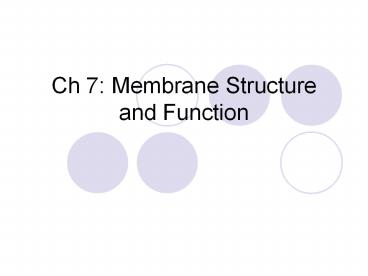Ch 7: Membrane Structure and Function PowerPoint PPT Presentation
1 / 21
Title: Ch 7: Membrane Structure and Function
1
Ch 7 Membrane Structure and Function
2
Fluid Mosaic Model
- Cell membrane
- Selectively permeable allows some substances to
cross more easily than others - 8 nm thick
- Fluid structure of phospholipids w/ a mosaic of
various proteins embedded in it - Cholesterol maintains fluidity acts as
temperature buffer - Less fluid as temp increases by restricting
movement - More fluid as temp decreases by maintaining space
3
Structure of Cell Membrane
4
Membrane Proteins
- Different types of cells contain different types
of membrane proteins - Integral proteins embedded into the hydrophobic
core of lipid bilayer, can go all the way through
membrane - Peripheral proteins
- on surface of membrane
5
Types of Membrane Proteins
- Transport
- Channel/ Carrier proteins (hydrophilic tunnel)
allow polar molecules and ions to pass through
hydrophobic layer - Channel and Carrier proteins are specific for the
substance they transport - Enzymatic
- Signal Transduction (chemical messages)
- Receptor proteins transmit information from
outside of the cell to inside of the cell - Cell Recognition
- ID tags glycolipids or glycoproteins
- Intercellular joining
- Join together adjacent cells
- Cell Support
- Attach to cytoskeleton or extra-cellular matrix
for stability
6
Passive Transport
- Passive Transport - Movement across the cell
membrane that does not require energy - Diffusion movement of particles from an area of
high concentration to an area of low
concentration until an equilibrium is reached (go
with/ down its concentration gradient) - Concentration gradient the difference in the
concentration of a substance across a space - Equilibrium conc. of a substance
- is equal throughout a space
- (doesnt stop moving)
7
Osmosis
- Osmosis diffusion of free water across a
selectively permeable membrane - Water diffuses across the cell membrane from the
region of low solute conc. to that of a higher
solute - conc. until it
- reaches equilibrium
8
Osmoregulation in Cells w/o cell walls
- Osmoregulation control of water balance
- Tonicity ability of a solution to cause a cell
to gain /lose water - Isotonic solution no net movement of water
across the cell membrane - Hypertonic solution more free water inside the
cell . cell will lose water to its environment,
and shrivel - Hypotonic solution less free water inside the
cell . water will enter cell, it will swell and
lyse - Some cells have a contractile vacuole to pump
water out of cell
9
(No Transcript)
10
Osmoregulation of Cells w/ walls
- Plant cells are healthiest in a hypotonic
solution, osmotic pressure keeps cell wall turgid
(very firm) - Plant cells are flaccid (limp) in an isotonic
solution - In a hypertonic solution, the cell membrane will
shrink and pull away from the cell wallcalled
plasmolysis (wilt)
11
(No Transcript)
12
Facilitated Diffusion Passive Transport aided
by proteins
- Channel Proteins hydrophilic passageways
- Some are always open for diffusion
- Rate of movement is determined by conc. Gradient
- () charged ions more likely to diffuse INTO cell
- (-) charged ions morel likely to diffuse out of
the cell - Some ion channels have gates and can be opened
by - Stretching of cell membrane
- Change in electrical charge
- Binding of specific molecule
13
Voltage Gated Channels
- Nerve Cells transmit electrical signals by
opening a series of Na gated channels - Channel is closed
- Area changes voltage
- Channel opens briefly
- Na flood into cell voltage changes
- Channel closes and electrical signal passes on to
the next voltage channel
14
Chemically Gated Channels
- Nerve cells send out a neurotransmitter called
acetylcholine (ACh) to nearby muscle cells to
signal muscle to contract - ACh binds to ACh receptor protein
- Receptor gate opens for a microsecond to allow
Na in - Na sets off muscle contraction
15
Facilitated Diffusion Passive Transport aided
by proteins
- Carrier Proteins
- Specific substance binds to carrier protein
- Protein changes shape and transports substance
across cell membrane - Molecules is released into the cell, and carrier
protein returns to its original shape
16
Active Transport
- Active Transport - uses energy to move solutes
AGAINST conc. gradient - Carrier proteins act as pumps powered by ATP
- Examples
- Sodium Potassium pump
- Proton Pump
- Cotransport
17
Sodium Potassium pump
- Pumps 3 Na out of the cell and 2 K into the
cell - Actively transports both ions against their conc.
Gradient, powered by ATP - Prevents Na from accumulating in the cell
- 3 Na and a P (from ATP) bind to inside protein
pump - Pump changes shape transporting 3 Na across
membrane and out - 2 K bind to pump and are transported across
membrane - 2 K and P are released inside of cell
18
Proton Pump
- Actively transports protons (H) through the
internal membranes of mitochondria and
chloroplasts
19
Cotransport (Coupled Transport)
- Cotransport an ATP powered pump that transports
a specific solute, can indirectly drive the
active transport of several other solutes - Ex. As proton pump pumps H out, H diffuse back
into the cell pulling sucrose molecules into the
cell with it!
20
Bulk Transport Substances that are too large to
be transported by carrier proteins
- Exocytosis (export)
- Secretion of macromolecules by fusion of vesicle
with membrane, releasing the contents outside of
cell
21
Bulk Transport (contd)
- Endocytosis
- Cell membrane engulfs particles and pinches off
to form vesicle inside the cell. Vesicle may fuse
w/ lysosomes or other organelles - 3 Types
- Phagocytosis
- Pinocytosis
- Receptor-mediated

